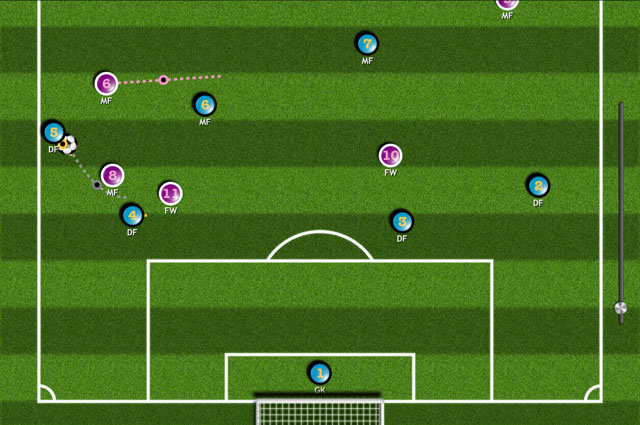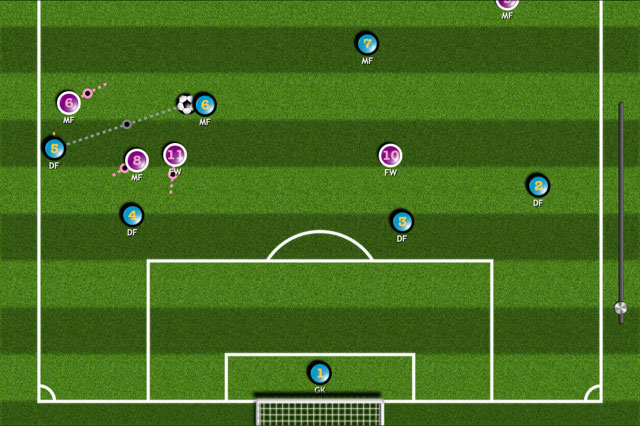It’s the first minute. The Young Socceroos captain Curtis Good takes a quick free kick deep in his own half, playing it back to his goalkeeper Paul Izzo.
A couple of passes later the ball is back at Good’s feet via Izzo, and he turns and plays a ball into the feet of his holding midfielder, Jackson Irvine.
Immediately Colombia’s Jose Leudo presses Irvine from behind. He can’t turn and face the Colombian goal, so he plays a short square ball out to left back Scott Galloway, close to the sideline.
Galloway, with a Andres Renteria putting pressure on him, can’t go forward, so he turns back and plays it to his skipper.
Good, too, is quickly pressed by John Cordoba. Suddenly it’s three-on-three and the Young Socceroos are being squeezed into their left hand corner.
In the technical-talk game it’s what’s often referred to as being “boxed-in”.

One-on-one, all three Young Socceroos accounted for, there’s very little space to operate.
Good, on the ball, is under immense pressure from Cordoba, with no obvious or open outlet.
Rather than panic, though, as many Australians teams in the past may have, he takes a touch and shifts the ball past Cordoba, towards Galloway.
In beating his man, he lures the Colombian attacker marking Galloway, Renteria, towards him.
Suddenly there is a small break from the one-v-one situation as Renteria leaves Galloway to try and dispossess Good.

But before he gets to Good, the central defender is able to get to the ball first and find Galloway.
Suddenly, with the two Colombians ahead of the Melbourne Victory left back, there is an opportunity to get the ball out of defence.

When Galloway turns, the Colombian that had been marking Irvine, Leudo, is forced to go across to shut Galloway down.
It leaves Irvine open, and Galloway is able play a square ball to his unmarked holding midfielder, who is now facing the Colombian goal, with no-one in front of him.

While there is pressure from behind from the back-tracking Cordoba and Renteria, Irvine can play an outlet ball out of defence to Danny De Silva, who has peeled away and found space on the left hand side of the halfway line.
While De Silva ultimately has his attempted pass into the feet of Adam Taggart intercepted, it is nonetheless an instructive build-up from Paul Okon’s men.
Coming in the first minute and being this team’s first build-up of the tournament, it showed that this batch of Young Socceroos, true to their manager’s word, was in Turkey to play, and play out.
More importantly, it showed that they had been instilled with the tools to play, and that’s a credit to the FFA technical team led by Han Berger and Alistair Edwards as much as it is to the work of current mentors Okon and Milan Blagojevic.
Ultimately the likes of Connor Chapman, De Silva and Adam Taggart are creatures of Australia’s development system, and, as I wrote on Saturday, it’s nice to see the early fruits of this hard work.
What the Young Socceroos demonstrated over the 90 minutes in Trabzon is that they have a clear understanding of how to play the indoctrinated 4-3-3 system.
With many of these players having lived and breathed he FFA’s guiding template for the past six or so years, their tactical and technical understanding came across in the performance.
Always looking to play out from the back through triangles, such as the one described above, it was very rare to see either of the central defenders hoof it long.
Indeed, if they were pressed and had no options, or couldn’t dribble past their immediate opponent, they would turn back to Izzo.
Only if Izzo was pressed and had no open options would the keeper play long.
Among the many encouraging aspects was that the team invariably looked to play forward angled balls, with the fullbacks, particularly Jason Geria, always presenting.
The fact they were able to get it into the feet of the talented 16 year old playmaker, De Silva, and the two wide men, Connor Pain and Andrew Hoole, so often, was most pleasing, particularly against a quality South American ball-playing opponent.
How often can we claim to have out-possessed and controlled such an opponent for large parts of the game?
Also pleasing was the mentality. Early, as the impressive Colombian left-footed playmaker Juan Quintero ran the show, the Young Socceroos stayed calm and disciplined.
Later, when Colombia equalised, the Young Socceroos might have gone into their shell. But they kept playing, and finished stronger.
While heart-warming, it wasn’t completely flawless, and there remains plenty for Okon and his men to work on in Turkey.
Primarily, I felt that Taggart, as the focal point in attack, was often isolated from his wide men, Pain and Hoole, as well as De Silva.
Often, I felt, the wide players may have tucked in, allowing for more combinations.
Certainly, as they build towards El Salvador on Wednesday morning, Okon and Blagojevic must ensure there is no complacency and they continue to execute.
To that effect, it was encouraging to hear De Silva talk about the importance of the mental preparation ahead of taking on the Central Americans.
What Okon and his boys will want to prove is that the process can produce consistently good performances, which should ultimately lead to results.
It’s the type of football that will also get the world talking and is a significant moment for those of us who have preached patience in the work being undertaken to shift Australia’s football focus from physical to technical.
What it should do is bring the skeptics, and there have been many, along the path.
Ultimately, it’s a performance that should not only be celebrated, but embolden the growing band of believers to strive for further technical progress.
































































































